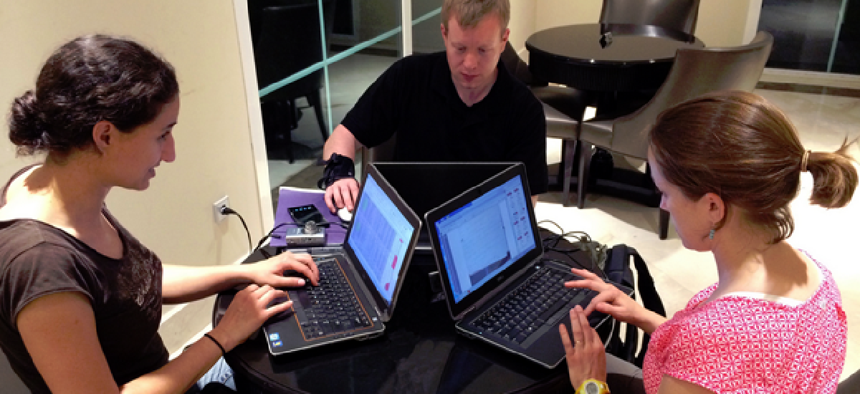How technology is helping fight Ebola


Connecting state and local government leaders
The tech and health care communities are deploying e-record systems, open data and mapping tools, cloud computing and even robots in the campaign to prevent the spread of Ebola.
The Ebola scare may turn out to be one of health care technology’s important trial runs, given the sheer number of apps, mapping tools, collaboration platforms and even robots that have been recruited for duty during the six-week-old crisis.
The electronic healthcare record system, for one, a core technology of the Obama administration’s plan to set up a data-driven health care system, is being promoted as a key epidemiological tool in the effort to screen potential Ebola carriers, according to a report in HealthData Management.
In 2013, the Centers for Disease Control and Prevention and the Office of the National Coordinator for Health IT established a Public Health Electronic Records Vendors Collaboration Initiative, which the agencies have asked to adapt the EHR system as a profiling tool for detecting Ebola carriers.
“The overall goal here is for us to explore ways in which the electronic medical record can serve as a prompt to help our health care professionals around the country identify individuals that may be at risk for Ebola,” said Dana Delman, deputy lead of CDC’s Medical Care Task Force (Ebola Response), during a recent CDC/ONC webinar seeking industry feedback.
In particular, vendors are being asked to consider including patient travel histories and records of Ebola clinical symptoms in electronic formats that can be used to help physicians flag people who might be virus carriers, according to HealthData Management.
The CDC has also developed an algorithm and checklist to evaluate patients for Ebola. According to Delman, CDC wants to explore “how we can translate this algorithm into an electronic medical record prompt and perhaps even a decisional tool.”
While EHRs can be outfitted as a kind of checkpoint system for helping track the virus, other tools are emerging that could bring the power of analytics and social media to bear on the virus.
CDC’s own Epi Info viral hemorrhagic fever (VHF) application helps locate people exposed to the deadly virus in a faster way. Epi Info VHF is an open-source program that runs on the Epi Info software platform. It lets users to set up databases of patient information, including names, gender, ages, locations, status – such as dead or alive – and Epi Case Classification, for suspected case, confirmed case or not a case.
And Microsoft Corp. said it would provide free cloud computing and research applications to qualified medical researchers working on the Ebola virus.
“One of the things we're going to do is make available Azure computer power to the research community," Microsoft chief executive officer Satya Nadella said at a presentation in San Francisco this month.
According to the company's website, Microsoft's research unit is "soliciting cloud computing proposals for projects that are working towards developing a better understanding of the spread and cure of the Ebola virus."
"In addition we have some tools that Microsoft researchers built to be able to do vaccine discovery, so we want to take all of that and make it available for the research community," said Nadella.
Qualifying proposals from researchers affiliated with academic institutions "will be awarded allocations of Microsoft Azure compute and storage," according to the website, resources that could support the use of analytics on large data sets associated with movement of the virus.
Cloud technology could also act as a platform for integrating tracking and virus mapping applications now emerging to help disease experts anticipate the path of a more serious Ebola outbreak in the United States.
In August, Flowminder, a Swedish firm, showed an application using big data to track Ebola, according to a report in MIT Technology Review. Using 2013 cell phone records from Senegal, the program was able to overlay past Ebola outbreaks on Senegalese traffic patterns to show the likely growth and direction of the virus in that country.
Social networking technologies and culture may be an even more powerful force for taming Ebola. In mid-October, about 100 public health technologists met in New York City for the Ebola Open Data Jam to share ideas, tools and tactics for chasing the virus.
The event was sponsored by NASA’s Jet Propulsion Lab along with IBM Research, the Africa Open Data Meetup group, as well as State Department and other government organizations.
Attendees were updated on projects to develop data management tools to map the outbreak. One involved tracing aerial imagery into Open Street Maps LINK application to give aid agencies a picture of the population density of the towns and villages affected by the virus.
Another group worked on contact tracing applications to enable healthcare responders to follow the virus by mapping all the individuals a carrier met a specific times and locations.
A project headed by former New York Senate CIO and founder of NuCivic Andrew Hoppin involved collecting and cataloging disparate data sources that come into play during a health disaster response. The group documented the metadata of the sources, then sorted them using the DCAT open data standard and published it to the website eboladata.org.
Exotic technologies including robots are also being trained to fight Ebola. A White House Office of Science and Technology workshop is planned next month to discuss how machines could help during health emergencies, including decontaminating rooms and moving supplies.
The key to using robots is close collaboration with people in the affected areas. “Being sensitive to the people at the center of the emergency will require something that the team already seems well aware of: keeping humans in the loop,” MIT Media lab researcher Kate Darling told BetaBoston.
NEXT STORY: NIST drafts guide for hypervisor security




